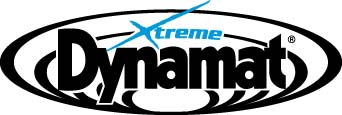Dynamat Xtreme is a patented, light-weight, elastomeric, butyl and aluminum constrained-layer vibrational damper.
Dynamat Xtreme conforms and fuses easily to sheet metal
and other hard substrates. Material performance is
optimized for temperature ranges between -10°C to +60°C
(14°F to+140°F). Material can withstand temperature
extremes between -54°C to +149°C (-65°F to +300°F) and
is highly resistant to aging. Dynamat Specifications:
Installation: Dynamat Xtreme should be cut to the desired size before
the release liner is removed. It may be cut with scissors, Coverage: How much is enough? Always the first good question. You do not need to cover the entire panel--edge to edge. Cutting the Dynamat material into one inch strips and spacing it out over a panel to achieve a 30 to 50 percent coverage will give you excellent sound deadening characteristics. The Knuckle Test: Rap your knuckles on the panel before you install any Dynamat to learn what a bare panel sounds like. Then adhere a one inch strip of Dynamat in the center of the panel. Rap it again to see out the sound has changed. Add another piece of material to the left and right of your center piece, splitting the difference between the edge of the panel and your center strip. Rap the panel again to hear how the sound has changed. Repeat this process until you are satisfied with the “density” of the sound level. Surface Preparation: The time spent in preparing the surface is equal to the satisfaction and success of your efforts. Whenever possible, sandblasting the surface of metal body panel and floor pans is highly recommended. On body panels fiberglass bodied cars, should be thoroughly cleaned before applying Dynamat. In floor and trunk pans, weld and seal any rust holes and then prime and paint the surface area as desired. Note: Dynamat is not a solution to the treatment of rust problems. Clean these surfaces with a metal prep type solvent material to remove all dirt, oil, tar, glue and wax deposits. The preparation of vertical surfaces is particularly important for adhesion. Contour Conditions: Dynamat can be heated with a heat gun to make it more pliable to stretch over humps and to penetrate valleys and crevasses. Heat the material—don’t cook it! Wear canvas or leather gloves to protect your hands from heated material. Multiple layers: The Vibra-Mat material is 0.70" thick. The mat material can be "built up" through multiple layers for greater sound-deadening capacity if needed. |
